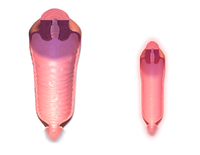
Photo from wikipedia
Infection-induced chronic inflammation is common in patients with endometriosis. Although microbial communities in the reproductive tracts of patients have been reported, little was known about their dynamic profiles during disease… Click to show full abstract
Infection-induced chronic inflammation is common in patients with endometriosis. Although microbial communities in the reproductive tracts of patients have been reported, little was known about their dynamic profiles during disease progression and complication development. Microbial communities in cervical mucus were collected by cervical swabs from 10 healthy women and 23 patients, and analyzed by 16S rRNA amplicon sequencing. The abundance, ecological relationships and functional networks of microbiota were characterized according to their prevalence, clinical stages, and clinical features including deeply infiltrating endometriosis (DIE), CA125, pain score and infertility. Cervical microbiome can be altered during endometriosis development and progression with a tendency of increased Firmicutes and decreased Actinobacteria and Bacteroidetes. Distinct from vaginal microbiome, upregulation of Lactobacillus, in combination with increased Streptococcus and decreased Dialister, was frequently associated with advanced endometriosis stages, DIE, higher CA125 levels, severe pain, and infertility. Significantly, reduced richness and diversity of cervical microbiome were detected in patients with more severe clinical symptoms. Clinical treatments against infertility can partially reverse the ecological balance of microbes through remodeling nutrition metabolism and transport and cell-cell/cell-matrix interaction. This study provides a new understanding on endometriosis development and a more diverse cervical microbiome may be beneficial for patients to have better clinical outcomes.
Journal Title: Biomedicines
Year Published: 2022
Link to full text (if available)
Share on Social Media: Sign Up to like & get
recommendations!